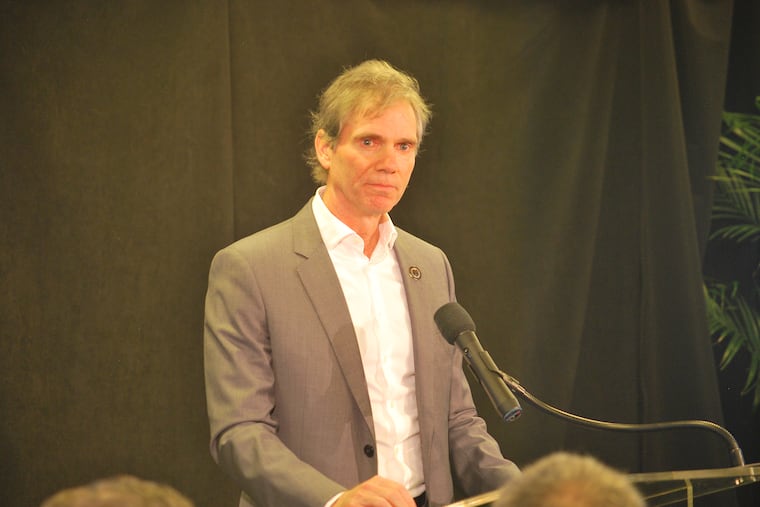Union owner Jay Sugarman enjoying one of the best stretches in team history, on and off the field
“This is the strongest I think we’ve gone into a season, not just on the field, but off the field,” he said. But he isn't resting on his laurels.

It’s a pretty good time to be Union majority owner Jay Sugarman.
His team capped off last year with its first playoff win, and it kicked off this year with Subaru buying the stadium’s naming rights.
“This is the strongest I think we’ve gone into a season, not just on the field, but off the field,” he told reporters Tuesday at Subaru Park.
But Sugarman made it clear he isn’t resting on his laurels.
“Last year, we showed that this is a team that can play in the upper echelon in the league — and that was with, frankly, a lot of pieces we were still trying to figure out, still trying to put in place,” he said. “Can we win the [MLS] Cup this year? I’m not going to count us out. … Fifty-five points [last year’s total in the standings] is the new benchmark. Let’s see if we can beat it.”
That is big talk, and Union fans will throw it back at him if the team flops. But whether the team hits 55 points or third place in the East again, there are good reasons to believe it won’t flop. As Sugarman alluded, this year’s squad is much more the kind sporting director Ernst Tanner wants than last year’s was.
“We started five years ago, really, with Earnie [Stewart] coming in and helping us really begin the [team’s] professionalization, and now you’ve seen Ernst come in and really take that to the next level,” Sugarman said. “I’ve spent a lot of time with [manager] Jimmy [Curtin] and [technical director] Chris [Albright] and Ernst, talking about how to really build an identity on the field that makes other teams have to react to us, and I think you’re going to see that."
A key piece of the puzzle is the return of Jamiro Monteiro. That happened in part because Sugarman signed off on a club-record transfer fee of more than $2 million. The Union’s only other seven-figure transfer fee was for Alejandro Bedoya four years ago.
The spending dynamic across MLS has changed in recent years from going big on salaries to going big on transfer fees. That has required a change in owners’ mentalities. Paying one-time sums for players is different from annual accounting — and different from any other American sport.
Sugarman acknowledged that he was a late adapter but acknowledged that he has evolved. Perhaps not as fast as Union fans would like, but he has.
“We’re willing to commit money behind things that we know will work,” he said. “We’re not so quick to spend money to just grab the latest, you know, fashion. … I think you’ll see us continue now, beginning where we are, to continue to add players who I think will elevate the entire team, while still respecting the fact that we’ve got a great pipeline of players coming up through the system."
In other words, Monteiro might be sold back to Europe if he plays so well that a club comes along with a big check. New midfielder Matej Oravec was signed for that purpose, as was Sergio Santos last year.
“We’re spending a lot of time, effort, and money, frankly, trying to be [home to] that next wave of talent,” Sugarman said. “It’s really Ernst’s mission to make this work for both pieces of the puzzle: to bring in those strong players that he identifies as undervalued and high-potential players, and then mix it with a pipeline of development players that we’ve had a chance to see in some cases since they were 7, 8 years old.”
If that plan works — and it has worked for plenty of soccer clubs worldwide — the Union will become a kind of destination team that MLS is becoming as a league: a launchpad to fame in the global game.
“I think what you’ve seen over the last couple of years is this belief that if we built the right foundation, that then when we brought in talent, those players would want to play for us,” Sugarman said. “It wouldn’t have worked, and I was not comfortable trying to force that, four or five years ago, when we didn’t really have a foundation.”
Sugarman will likely continue to take criticism from Union fans, and might well continue to earn it. There might still be whispers in the team’s training facility that he should open the checkbook a bit more — and MLS’ new collective bargaining agreement will force him to.
“I feel really good that this year, you can start to see all those individual elements that maybe you kind of said, ‘Well, that’s nice, but …’ ” he said. “We’re finally getting to a point where you can see the whole vision and say, ‘Ah, this is going to work.’ We’ve got the right people in the right places. We’ve got the right infrastructure. We’ve got the right foundation.”
Now, Sugarman added, the Union must “get that last 10 or 15% out of the club that will take us to the upper echelon of the league.”
Sugarman knows he has a role in that. He knows that, like any business, those last percentage points can be the hardest to get. And he knows that like any sports team, the best cure of all is winning.